If you’ve ever looked into live plants, chances are you’ve at least heard about java moss.
Java moss is one of the hardiest and most common plants in the aquarium industry. It’s been a staple since its introduction, and its popularity hasn’t waned.
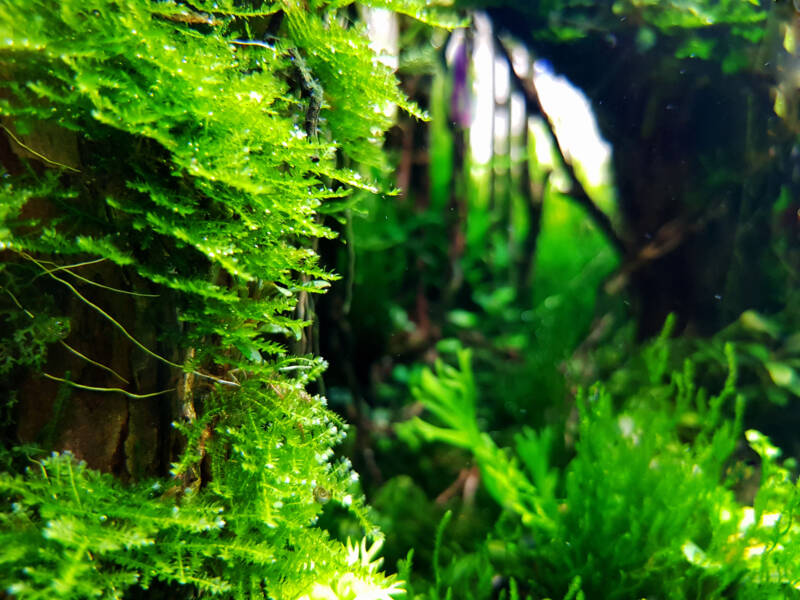
Java moss is common in almost all planted aquariums, whether owners are only looking to add some live plants for their fish or create intricate aquascapes for competitions.
If you’re looking for a plant that’s easy to care for and can be adapted for almost any use, then java moss is the plant for you.
Description and Availability
Java moss (originally Vesicularia dubyana but renamed Taxiphyllum Barbieri) is a green plant that is primarily comprised of short stems covered in tiny leaves.
The stems are so short, and the leaves are initially so compact that it can be hard to distinguish them. Thus, despite the irregular growth of the leaves, this plant can at first look like a green sheet.
Older growth tends to be a darker green, while new growth is often lighter in color.
The stems start out small but can grow from 3 – 10 inches long as the java moss matures.
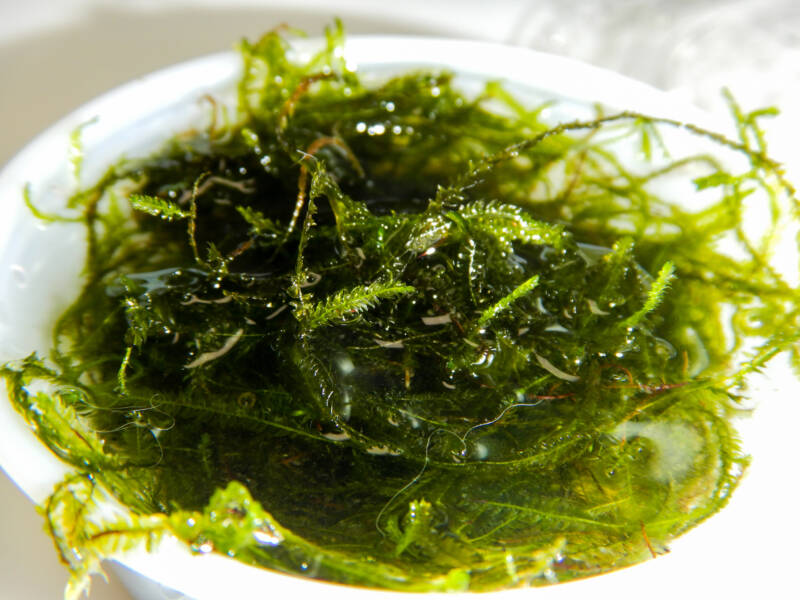
Java moss uses rhizoids to anchor itself, which are different than roots. Roots absorb nutrients, while rhizoids are only used to create a stabilizing/ anchoring network for the plant.
Because its rhizoids can’t absorb nutrients, java moss gets them via its leaves and stems.
Unfortunately, this means that root tabs and other forms of beneficial nutrients delivered via a substrate-related method are essentially useless. This makes liquid dosing the best option for making sure your java moss receives the correct nutrients and supplements.
Java moss is available in almost all fish shops that carry live aquarium plants. It’s also readily available online.
It’s one of the easiest mosses to shop for, as it’s almost always in stock and often sold with bulk options available.
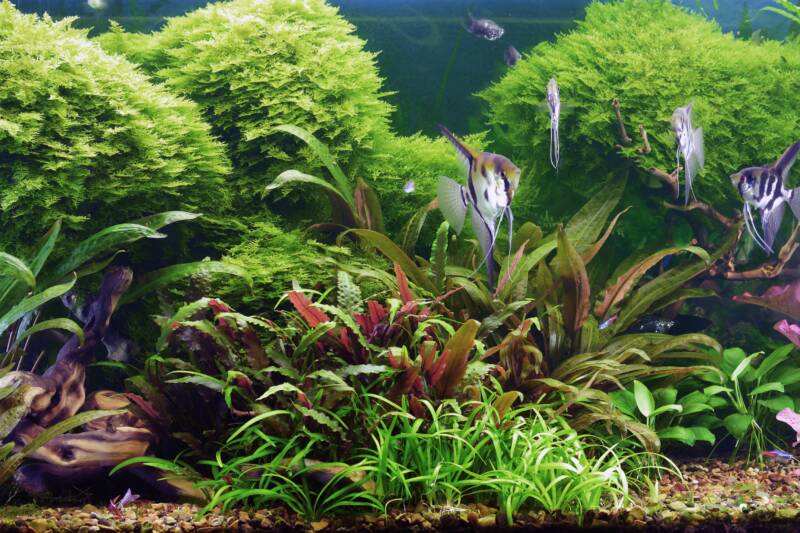
Natural Habitat
Java moss is originally from Southeast Asia.
It can be found growing submersed (hence its use in the aquarium trade), or partially submerged or growing above the water in moist climates.
You can easily find it growing on rocks and tree trunks, for example. It will attach to almost anything, except fish themselves or other living neighbors such as shrimp, snails, etc.
In the wild, fish use this plant for hiding/ protection, breeding, eating, and territorial claims.
It’s commonly used for those same purposes in home aquariums, but can also be used to create beautiful underwater landscapes.
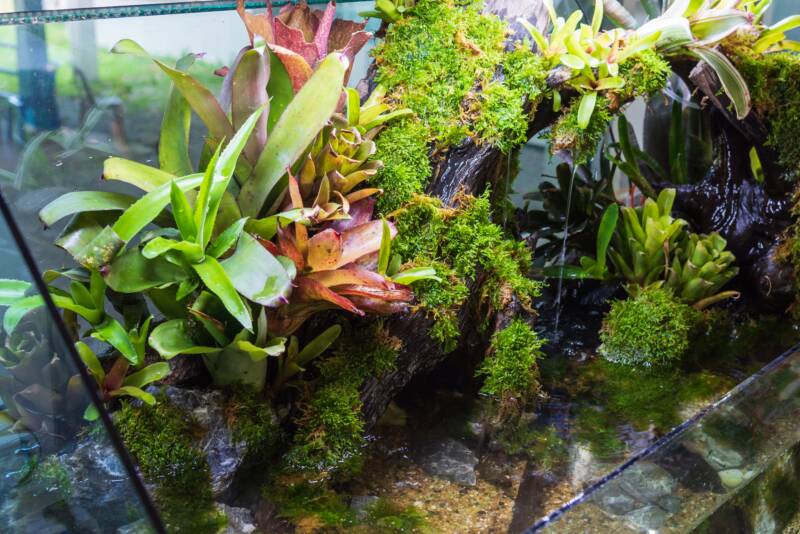
Tank Setup
Java moss can technically be grown in any size aquarium. However, it’s difficult for water to stabilize in tanks under 5 gallons.
This moss has been successfully used in micro and nano tanks that are smaller than this. However, these tanks require significantly more upkeep and often can only support plants, not fish.
Because of this, if you want to keep fish and plants, it’s recommended that you start with tanks that are a minimum of 5 gallons.
Beyond this, java moss can be grown in almost any environment. It can support a wide range of water parameters and is very hardy.
Similar to duckweed, it would take more effort to kill this moss than to grow it successfully.
Aquarium Equipment
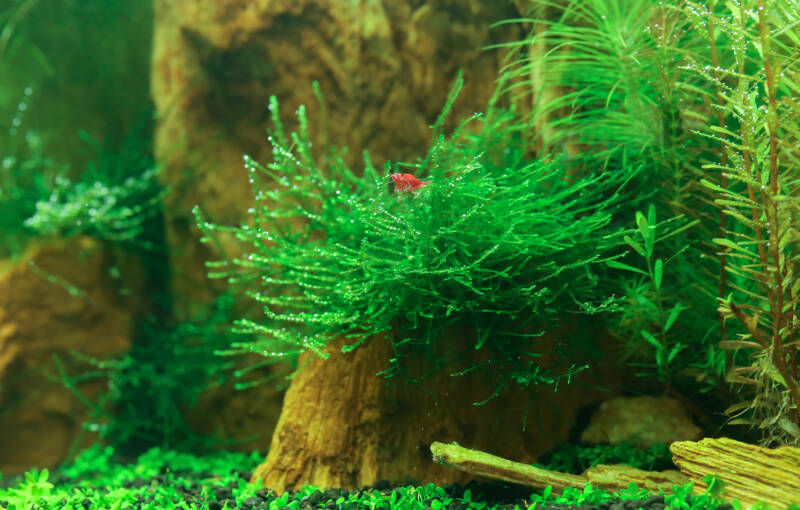
There are no real requirements for the equipment used in aquariums that have java moss.
More often than not, aquarists add this plant to a preexisting tank with the understanding that this moss will adapt, rather than creating a tank set up around the needs of java moss.
In fact, it’s likely that you already have all the equipment you need to keep it successfully.
- Filtration: Any type of filter is acceptable to use with this plant: HOB, undergravel, internal, canister. If you have it, chances are it’s fine.
- Heating: Though it does better in colder water, java moss grows fine in warmer water. If you already have a heater, keep it at whatever temperature best suits your tank inhabitants.
- Lighting: Java moss can grow in both high light and low light setups. It will grow faster in high light, but then aquarists may also have to worry about algae.
- CO2: Like any plant, CO2 set up will make java moss grow faster. However, it will also spread fine without CO2, either in gas or liquid form.
Not much is required for java moss to grow. Whether you have a low tech or high-tech tank, it will adapt to spread and thrive.
This is another reason why it’s an excellent plant for aquarists on a budget.
This moss can adapt to whatever equipment you choose that best suits your fish and wallet, and is a very cheap plant to buy.
But even though it can survive under most conditions, java moss still has water preferences that will make it grow faster and healthier.
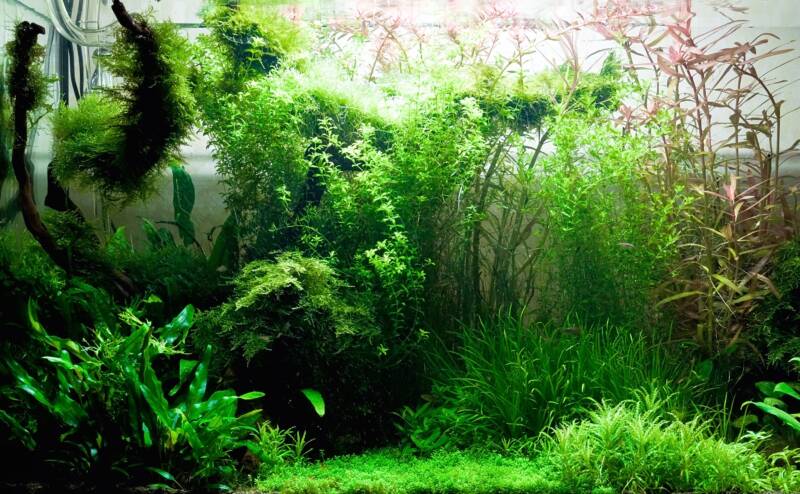
Water Parameters
The water parameters below will ensure java moss grows as quickly as possible. Maintaining these parameters will also make it grow in thick clusters, as opposed to slimmer strings.
Knowing how to control moss’ growth and what spurs which appearance is also very beneficial for aquarists who want a distinct look for their aquarium.
- Temperature: Java moss prefers a temperature range of 59 – 82°F (15 – 28°C). The warmer the water is, the slower this plant will grow. Warmer water also produces a lankier plant, as opposed to the compact clusters.
- pH Range: A pH range of anywhere between 5.5 – 8 is ideal for this moss. However, it can tolerate fluctuation in more acidic or more basic ranges. Again, erring away from the stated pH values will cause thinner growth.
- Water Hardness: This plant does well when kept at 6 – 20 dGH. This is a very broad range that most aquariums meet anyway. Java moss will also do fine in tanks that are kept outside this range.
But keep in mind that these parameters are by no means set. Many aquarists introduce java moss to aquariums that don’t meet any of these water parameters, and it does fine.
All plants absorb nitrates and help keep a high water quality, but this doesn’t mean that nitrates don’t negatively affect them or other fish. Because of this, it’s better to try and keep ammonia, nitrites, and nitrates as close to 0 ppm as possible.
A good starting point is 25% changes every week. Aquarists can tweak the frequency and amount of the changes according to their needs over time, guided by regular water testing, and observing how it may affect the tank inhabitants.
Uses in the Aquarium
Java moss can be used for various purposes that vary depending on the needs of the aquarist and fish.
One of its primary uses is as an aquascaping tool. This moss can be used to simply cover some dragon stone or create a literal dragon statue. The possibilities are endless!
So if you can imagine it, chances are you can do it with java moss.
It can be attached to rocks, driftwood, other plants, substrate, or any other inert object that will allow it to anchor.
To keep this moss tied to whichever object you choose, you can use the fishing line until its rhizoids grow enough to keep the plant attached without the use of other aids. The fishing line can be removed after a few weeks or left for the rhizoids to grow over.
Aquarists primarily use java moss as a foreground or midground plant, though it can be placed in the background.
Some tank owners don’t use it in these traditional ways and instead look for different presentations.
The versatility of this plant leads to both classic and creative uses, such as:
Forming carpets or walls
One of the most popular uses for java moss is to create a stunning carpet or statement wall along one side of the aquarium.
To start a carpet, cut the moss and anchor it at specific points throughout the bottom of the tank.
To create a wall, place it between two sheets of mesh, which are anchored via a suction cup or another method against the desired wall. The moss will grow and eventually spread across the entire tank floor or wall.
Aquascaping
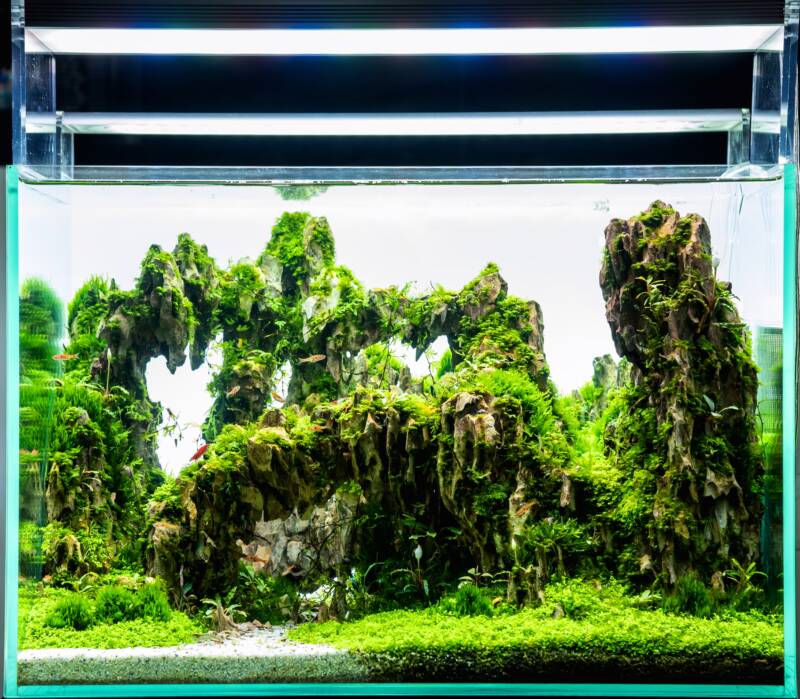
Java moss can provide contrast, introduce varied texture, direct the eye of the viewer, or create the desired look.
It provides an excellent juxtaposition to tall and smooth plants, specifically those with slimmer leaves, stems, or stalks.
Hardscapes mainly use rocks and driftwood and can create a beautiful but stark environment. Using a plant like java moss softens the overall ‘scape and creates a more natural look and feel.
It also has the bonus of helping aquarists maintain high water quality.
Fish’s Natural Habitat
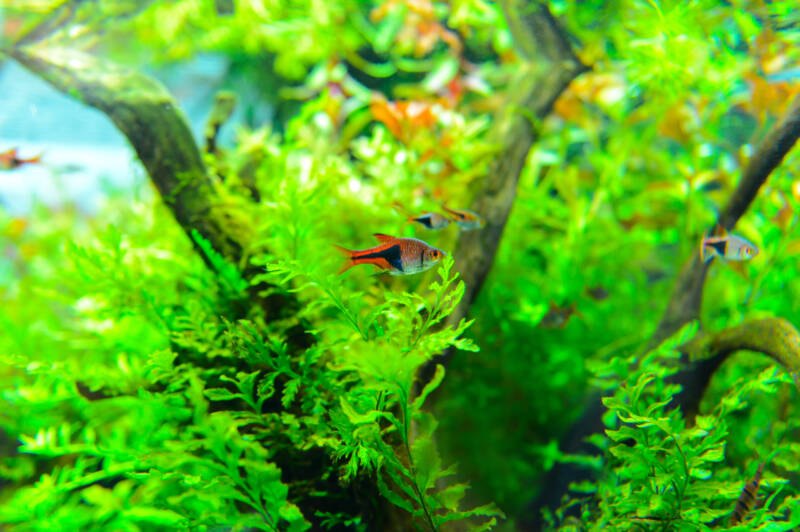
Java moss can help to recreate the natural habitat of fish that come from Southeast Asia, where this plant also originally grows.
For fish or other aquatic inhabitants to display their most natural behavior and have the best quality of life, it’s recommended to recreate their habitat.
Java moss easily allows aquarists to do this.
Breeding medium
Many mosses are used in regular aquariums and specific breeder tanks since fish and other tank inhabitants love it.
It’s a perfect place to lay eggs or raise fry in.
This is because its leaves create a thick blanket (if trimmed purposefully) or tangle (if allowed to grow freely) that can hide, and protect fish parents and fry.
Underwater Bonsai Tree
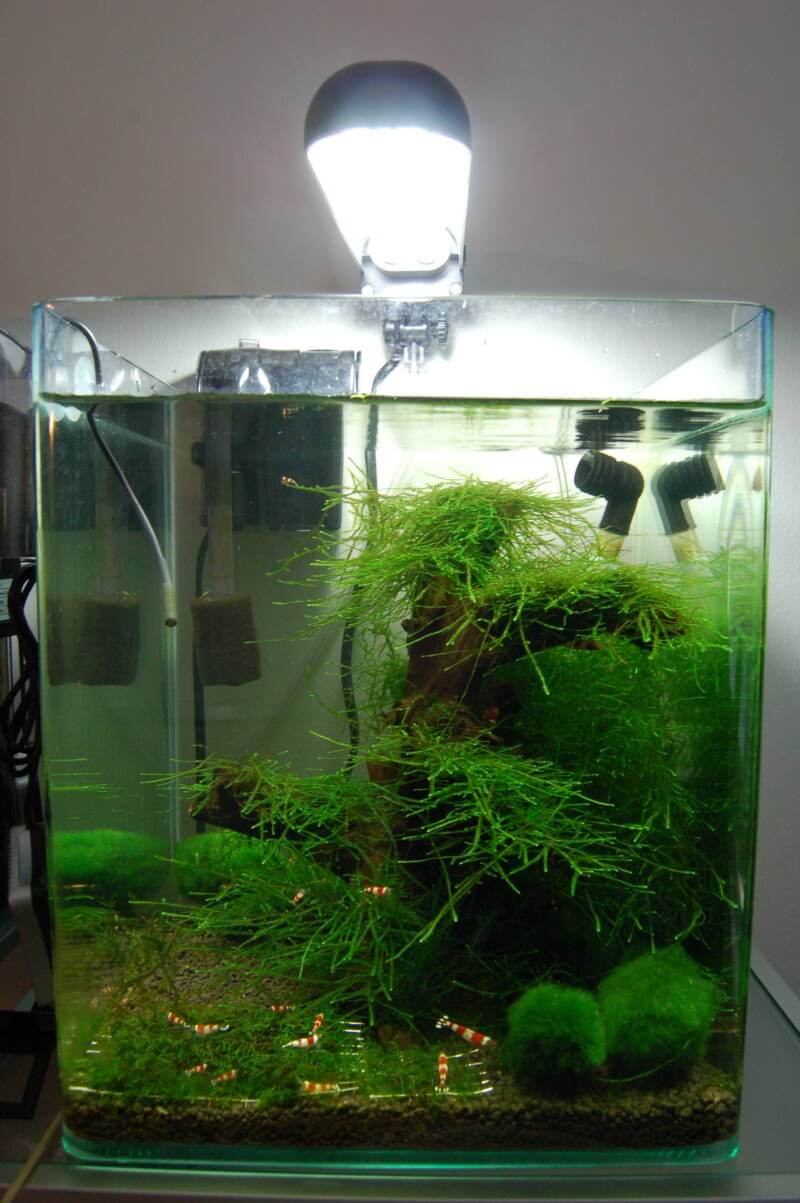
Using it as the “leaves” for an underwater bonsai tree.
Using the preserved wood from a real bonsai tree, moss can be spread over the branches and tied down.
As it anchors and spreads, aquarists trim it to encourage horizontal rather than vertical growth. Eventually, it will cover the branches and look similar to the original foliage of a bonsai tree.
Common Problems
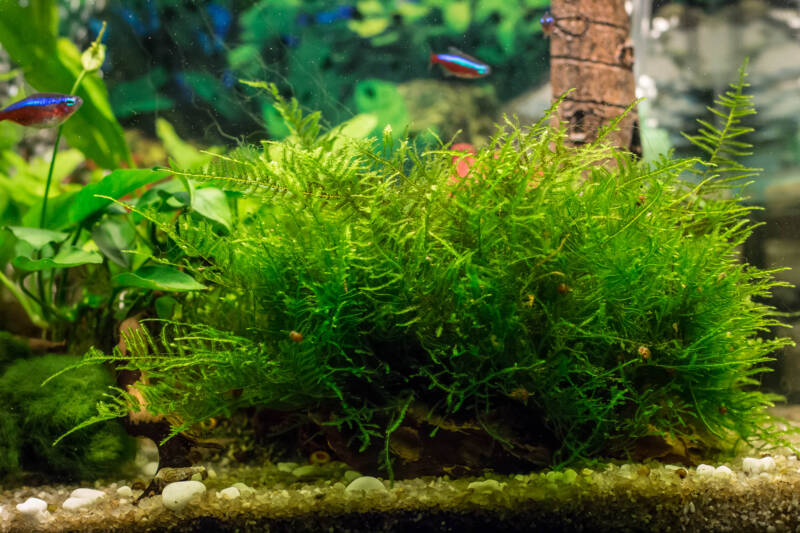
Even though this moss is easy to care for and propagate, it’s not perfect. There are two primary problems that aquarists have to deal with:
- Excessive and untrimmed growth, which can lead to moss tangles and dead patches.
- Excessive algae growth caused by an imbalance in the light, CO2, nutrients, and water conditions.
The first problem can be solved by regularly trimming your plant. This is done using a sharp pair of scissors so that the cuts are clean and not ragged or torn.
For those that prefer the “untamed” or “natural” look of java moss, pruning can be done semi-frequently and sparingly.
Keep in mind; this only is an issue if you allow it to grow naturally in clusters.
Algae problems are harder to solve. The structure of java moss means that algae are quickly able to take hold and spread.
More often than not, aquarists are forced to throw out the entire batch of moss and start fresh with a new plant.
For people who don’t want to do this, algae can be removed (painstakingly) with a soft-bristle toothbrush, but this is only a temporary solution. To solve the problem permanently, you’ll need to find and correct the imbalance in your tank.
Adding Java Moss to Your Tank
Java moss is one of the most popular plants in the aquarium hobby, and for a good reason.
It’s hardy, easy to care for, aesthetically pleasing, and readily available— and these are just a few of its benefits!
This moss is loved by both beginners and experienced aquarists alike. It’s often one of the first plants new aquascapers use in their setups and remains a staple for most tanks.
Adding it to your tank is a decision that’s sure to benefit you and your fish. You’ll receive a resilient and beautiful plant that is likely to survive as long as or longer than any of the other plants and tank inhabitants.
Your fish will receive enrichment and added nutrients, as well as a potential source of protection, food, or breeding medium.
There’s no way to go wrong with this plant. So if you’re looking to add some more greenery to your aquarium, java moss is probably the right plant for you!
